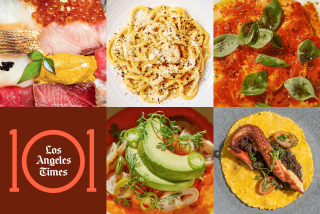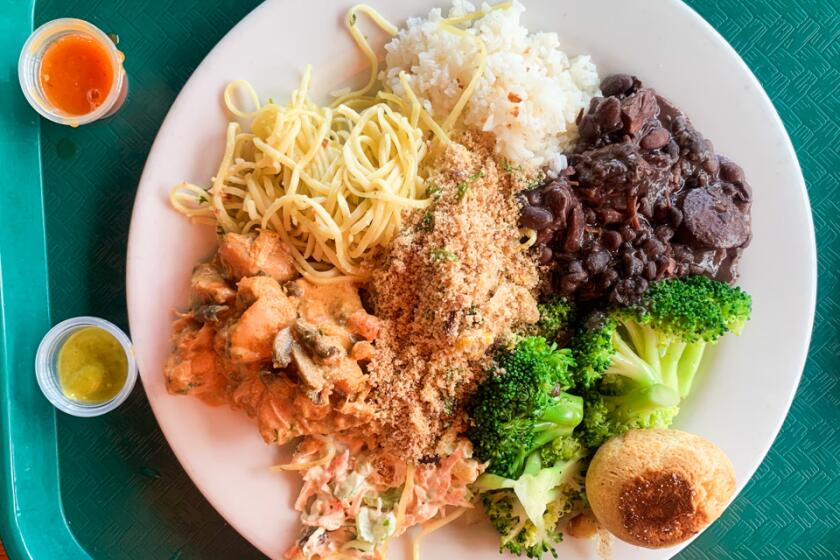The brightest twist
Limes are the unsung summer fruit.
They seem about as seasonal as onions, sitting there patiently in the produce aisle month after month as the calendar pages turn. But this time of year they look different. They’re bigger, they’re greener, they feel juicier when you grab them. Most telling, they’re priced to sell .
All those are classic symptoms of prime condition and peak supplies, and they’re exactly why my refrigerator has a drawer filled with limes right now. With their slightly sour but seriously fruity taste, Persian limes are made for summer cooking. Lemons need sugar. Limes are tangy enough to almost eat straight. Probably no other ingredient can enhance so many August indulgences with such a light squeeze. Limes add tart jazz to raspberries and strawberries, green beans and avocados, mangos and wild salmon, soft-shell crabs and even corn on the cob (juice a lime over a buttered ear, dust with chili powder and prepare to bite into another dimension).
Most people think of limes, if they think of them at all, as potential slices for sparkling water, or as the tequila-cutter in margaritas. But to me they are almost as essential as onions. Any recipe that calls for lemon will work even better with lime -- the substitution makes a dish a little twisty (lime meringue pie sounds almost exotic). I use lime instead of lemon in my bottomless-refill iced tea, in my cucumber yogurt soup and in just about any recipe where I want more flavor than bite.
Limes are not sweeter than their yellow cousins, but they seem fruitier. Their zest has a deep, almost oily pungency that, combined with the juice, comes through assertively even in baked desserts that tend to lose citrus intensity in the heat of the oven.
Lime is good raw, in a tuna ceviche with mangos and serrano chiles, and cooked, in a tart beurre blanc that makes a vibrant glaze for wild salmon filets or grilled veal chops. In fact, you can just about squeeze a meal out of limes, zinging every course from soup to salad to souffle.
Persian limes are a fat hybrid of the tiny Key (or Mexican) lime and another fruit called citron, which is now grown primarily for its rind. Unlike Key limes, which are all juice, Persian limes have a thick peel with a lot of pungency. They’re the commercial favorite because they resist bugs and chill better than Key limes. They also are picked green partly to distinguish them from lemons -- left on the tree, they would turn orange and ultimately yellow. The flavor wouldn’t change by ripening, however; they’d still be just as sour.
Tropical zest
The dark zest of that green peel is perfect for pumping up the lime flavor in desserts such as a blueberry tart with a sour cream filling or an old-fashioned pudding cake, the kind that separates as it bakes into both light cake and tangy sauce. Using only the zest, you can ratchet up the flavors without affecting the chemistry of a recipe, as in a buttery shortbread that would turn soggy if the juice were used.
I was first taken with limes on trips to the Caribbean, where bartenders were always squeezing them to make that quintessential cocktail called a rum punch, with twice as much dark rum as fresh juice, supplemented by simple syrup and lots of just-grated nutmeg over the top. To me there is no better-balanced mixed drink.
Limes are more common than lemons in the cooking of the Caribbean too, paired with fish or many other dishes. That may be why West Indian flavors seem most complementary with lime. I usually add a dash or two of Angostura bitters, from Trinidad, to accentuate the lime flavor in things such as shortbread and definitely in a rum punch. Nutmeg and ginger are also good partners -- freshly grated ginger gives a haunting back note to the lime in a pudding cake, for instance.
Mexican cooking also puts limes ahead of lemons in the kitchen. A little wedge is the garnish on any plate of tacos; a lot of juice “cooks” shrimp or scallops for ceviche. And Mexican mayonnaise, homemade or store-bought, takes on an edge from a little lime.
In Cuba, lime is the essential ingredient in the ubiquitous mojitos as well as those old-fashioned daiquiris in the Hemingway bar. But you will often see a slice or two tucked onto a plate of rice and beans in a country where seasonings are hard to come by. Just as lemons are great at vivifying dull fish, limes have terrific flavor-waking potential.
Like almost all citrus besides grapefruit, limes originated in Asia (most likely Malaysia) and were first cultivated in India. Their big moment in food history came in the late 1700s when the British deduced that the ascorbic acid (a.k.a. vitamin C) they contain prevented scurvy.
The vitamin may be the one redeeming attribute of the juice in those little plastic limes you find in the supermarket; that stuff is rather flat. You’re better off starting with two little tools rather than using the commercial juice. The Microplane, which shaves off the rind into the airiest wisps, is the best tool ever invented for zesting citrus. And the reamer, a gadget that I seem to get repeatedly as a hostess gift for reasons I’d hate to analyze, extracts the juice out more effectively than a flat juicer.
As with other citrus, rolling limes around a few times before squeezing them will help produce the most juice. But shopping is also key: I buy only limes that are soft enough to squeeze easily.
And I always have them on hand, in the event of some catastrophe that calls for an immediate rum punch infusion. Stored in a plastic bag in the crisper of my unreliable refrigerator, they last for weeks. Or until the urge strikes.
In darkest winter, a rum punch with lime is like a ticket to the virtual tropics. Drinking one in February always takes me straight back to Grenada.
But rum punch is really the symbol of summer. If we have a party over Memorial Day weekend, we make rum punch by the pitcherful to celebrate the beginning of the season. And if we have a party over Labor Day, it’s rum punch to mourn the end.
*
Rum punch
Total time: 5 minutes
Servings: 1
Note: To make a simple syrup, combine equal amounts of sugar and water in a small saucepan. Bring it to a boil, reduce the heat and simmer to dissolve the sugar. Let it cool completely. It will keep, stored in a covered container in the refrigerator, for several months. For a slightly different flavor, substitute 1/2 jigger maple syrup for the simple syrup.
1 jigger (1 1/2 ounces) fresh lime juice
1 jigger (1 1/2 ounces) simple syrup
2 jiggers (3 ounces) dark rum, preferably from Barbados
2-3 dashes Angostura bitters
1 jigger (1 1/2 ounces) cold water
Fresh nutmeg
1. Combine the lime juice, simple syrup, rum and bitters in an ice-filled glass jar with a tight-fitting lid. Add cold water. Shake until it is completely mixed. Taste and add more simple syrup, bitters or lime if you like -- it should be tart but still sweet. Pour over ice in a squat glass. Grate the nutmeg thickly over the top and serve. (Components can be scaled up in direct proportion to make a pitcherful.)
Each serving: 278 calories; 0 protein; 23 grams carbohydrates; 0 fiber; 0 fat; 0 saturated fat; 0 cholesterol; 1 mg. sodium.
*
Ginger-lime pudding cake
Total time: 1 hour
Servings: 4
1/4 cup flour
3/4cup plus 2 tablespoons sugar
1/4 teaspoon salt
4 tablespoons grated lime zest, divided
2 teaspoons finely grated ginger
2 eggs, separated
1 cup milk
1/4cup freshly squeezed lime juice
Whipped cream for garnish
1. Heat the oven to 350 degrees.
2. Combine the flour, sugar, salt, 3 tablespoons of the lime zest and the ginger in a large mixing bowl and whisk to blend, breaking up the clumps of ginger. In a small bowl, beat the egg yolks with the milk. Add the egg yolk mixture, along with the lime juice, to the flour mixture and mix until blended. Beat the egg whites until stiff and fold them into the egg-flour mixture gently but thoroughly. Pour into a 1-quart souffle dish or four 6-ounce ramekins.
3. Set the souffle dish or ramekins in a baking pan and pour hot water around them to a depth of 1 inch. Bake until the top is set and golden brown, about 45 to 50 minutes for a souffle dish or 30 minutes for ramekins. Immediately remove them from the hot water bath. Serve warm or cold, with whipped cream sprinkled with the remaining lime zest.
Each of four servings: 281 calories; 6 grams protein; 55 grams carbohydrates; 1 gram fiber; 5 grams fat; 2 grams saturated fat; 114 mg. cholesterol; 207 mg. sodium.
*
Blueberry-lime tart
Total time: 2 hours, plus cooling
Servings: 8
Note: The tart crust recipe is adapted from one in “The Silver Palate Cookbook” by Julee Rosso and Sheila Lukins (Workman, 1982). It is only partially baked; the baking will be finished after it is filled.
Sweet, buttery tart crust
1 2/3cups unbleached flour
1/4cup superfine sugar
1/2 teaspoon salt
10 tablespoons (1 1/4 sticks) unsalted butter, chilled
2 egg yolks
1 teaspoon vanilla
2 teaspoons ice water
1. Combine the flour, sugar and salt in a large mixing bowl and whisk to blend. Cut the butter into thin slices and add to the bowl. Using only the tips of your fingers, rub the butter into the dry ingredients to make coarse crumbs. (Do not use your palms, which will warm the dough.)
2. Stir together the egg yolks, vanilla and ice water. Add to the dough and toss with a fork until the mixture clings together, 30 to 45 seconds. Turn the dough out onto wax paper and shape into a ball. Using the heel of your hand, press the dough together until all the dry bits are incorporated. Wrap in wax paper and chill 30 minutes.
3. Roll the dough out between sheets of wax paper to make a thin crust. Remove the top sheet of paper, invert the crust over a 10-inch tart pan and remove the remaining sheet of paper. Fit the crust into the pan. Cut away the excess dough from the rim. Freeze 30 minutes.
4. Heat the oven to 425 degrees.
5. Line the dough in the pan with foil and then fill with pie weights or dried beans. Bake in the lower third of the oven for 8 minutes. Remove the foil and weights. Lightly prick the bottom of the dough in a few places with a fork.
Filling
3/4cup sour cream
2 large eggs
1/3cup sugar
3 tablespoons lime juice
2 tablespoons lime zest
Pinch salt
1 pint fresh blueberries, rinsed, stemmed and patted dry
1 (10-inch) tart shell, partially baked
1. Heat the oven to 350 degrees.
2. Make a custard by combining the sour cream, eggs, sugar, lime juice and zest and salt in a medium mixing bowl and whisking until smooth. Arrange the blueberries in the tart shell and pour the custard over.
3. Bake on the center rack in the oven until the edges of the custard are just set but the center is still jiggly, 25 to 30 minutes. Cool completely on a rack before cutting.
Each serving: 371 calories; 6 grams protein; 39 grams carbohydrates; 2 grams fiber; 22 grams fat; 13 grams saturated fat; 155 mg. cholesterol; 196 mg. sodium.
*
Tuna ceviche with mango and lime
Total time: 45 minutes
Servings: 4
Note: Tomato or avocado can substitute for the mango.
1/2pound super-fresh, top-quality tuna
2 firm but ripe round red mangoes
2 to 3 serrano chiles, seeded and finely chopped
2 tablespoons finely chopped cilantro, or to taste
1 teaspoon minced red onion, or to taste
3 tablespoons extra-virgin olive oil
3 tablespoons freshly squeezed lime juice, or to taste
Sea salt and freshly ground black pepper to taste
1. Cut the tuna into 1/2-inch dice. Peel the mangoes and cut them into the same size dice. Place them in a glass bowl, add the chiles, cilantro, red onion, olive oil, lime juice, salt and pepper and toss them with a rubber spatula until thoroughly mixed. Cover with plastic wrap and marinate in the refrigerator for 30 minutes, or until “done” to your taste. Taste and add more seasoning if needed. Serve on saucers, tortilla chips or in lettuce leaf cups.
Each of four servings: 223 calories; 14 grams protein; 19 grams carbohydrates; 2 grams fiber; 11 grams fat; 2 grams saturated fat; 26 mg. cholesterol; 24 mg. sodium.
*
Lime-herb beurre blanc
Total time: 10 minutes
Servings: 4
Note: This is great on poached salmon or grilled veal chops or with steamed lobster.
2 tablespoons fresh lime juice
1/2 cup fruity wine or sweet vermouth
3 tablespoons minced shallots
1 tablespoon grated lime zest
6 tablespoons cold unsalted butter, cut into slices
1 tablespoon thinly sliced basil or mint leaves, or chopped chives
1/2 teaspoon sea salt
Freshly ground white pepper to taste
1. Combine the lime juice, wine or vermouth, shallots and zest in a nonreactive saucepan or skillet. Cook over high heat until only 1 tablespoon of the liquid remains.
2. Remove from heat. Immediately whisk in 2 slices of butter and whisk vigorously until it is incorporated. Continue whisking in the butter a slice at a time until the sauce is emulsified. Add the herb of your choice. Season with salt and pepper to taste. Serve hot.
Each of four servings: 207 calories; 1 gram protein; 6 grams carbohydrates; 0 fiber; 17 grams fat; 11 grams saturated fat; 47 mg. cholesterol; 297 mg. sodium.
More to Read
Eat your way across L.A.
Get our weekly Tasting Notes newsletter for reviews, news and more.
You may occasionally receive promotional content from the Los Angeles Times.






